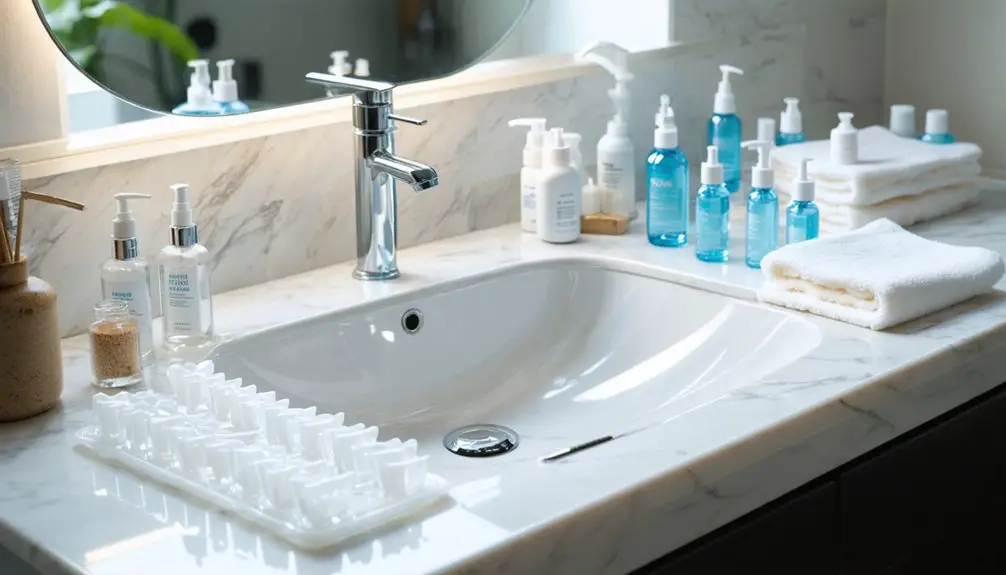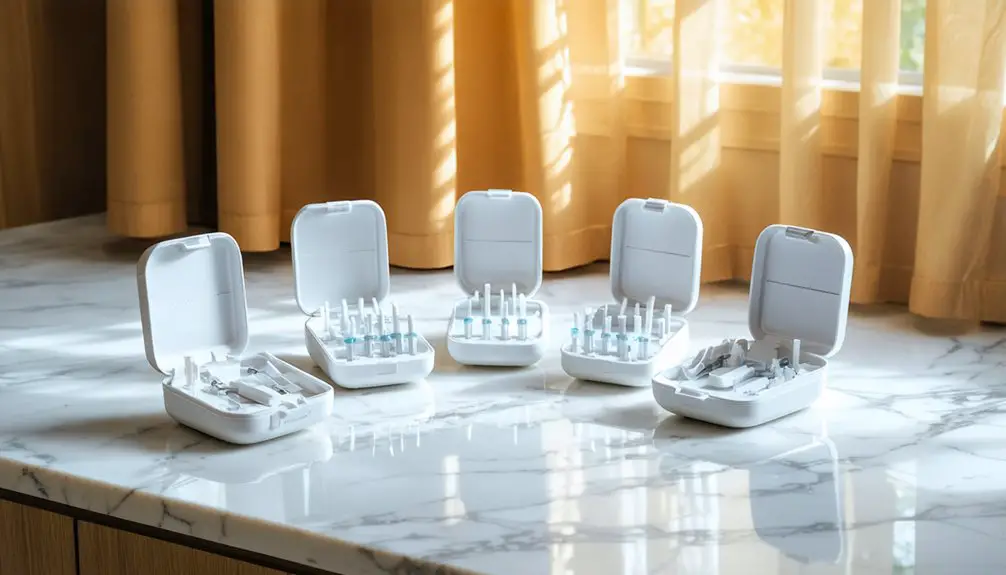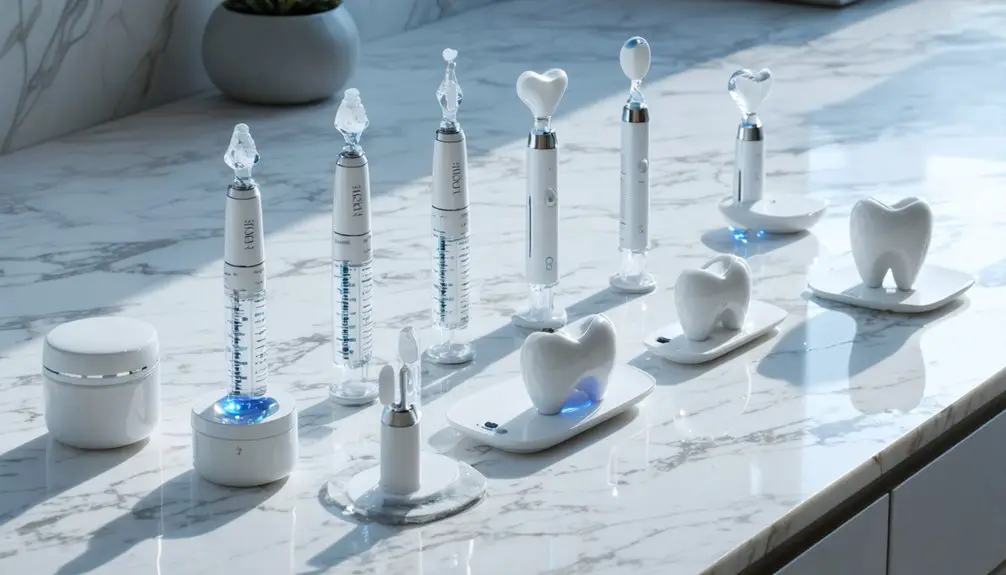You can effectively whiten your teeth at home using FDA-approved kits containing hydrogen peroxide or carbamide peroxide. For ideal results, choose products with 3.5-10% concentration and apply them daily for 20-30 minutes over two weeks. While whitening strips offer convenience, tray-based systems provide more thorough coverage. Monitor for sensitivity and follow application instructions carefully. Understanding the science behind teeth whitening will help you achieve the brightest results safely.
Key Takeaways
- LED whitening kits combined with hydrogen peroxide gel can produce visible results within one week of regular use.
- Professional-strength tray systems with 35% carbamide peroxide deliver dramatic results through 20-30 minute daily treatments.
- Whitening strips offer convenient application and noticeable improvements within two weeks of consistent use.
- Choose ADA-approved products containing up to 10% hydrogen peroxide for safe and effective at-home whitening.
- Target both surface and deep stains by following recommended treatment times and using custom-fitted trays for optimal coverage.
Understanding How Teeth Whitening Actually Works
To understand how teeth whitening works, you’ll need to first grasp the basic structure of teeth and how staining occurs. Your teeth consist of three main layers: the outer enamel, middle dentin, and inner pulp.
Despite common whitening myths, stains can penetrate beyond the surface, settling both on and within the enamel’s porous structure. The naturally yellowish dentin layer underneath can become more visible as enamel thins with age. Teeth may also discolor internally from fluoride overexposure during tooth development.
Teeth stains aren’t just superficial – they can work their way deep into your enamel’s tiny pores, creating lasting discoloration.
When you apply whitening agents containing peroxides, they penetrate your enamel to target both extrinsic and intrinsic stain types. These agents release reactive oxygen species that break down stain molecules’ chemical bonds through oxidation.
This process changes how light reflects off your teeth, making them appear whiter. The whitening chemicals work through your enamel’s microscopic channels, reaching deeper discoloration while maintaining your tooth’s structural integrity.
Top Active Ingredients That Deliver Results
Now that you understand the science of teeth whitening, let’s examine the key ingredients responsible for those bright results.
When comparing the efficacy of active ingredients in home whitening products, two peroxide compounds consistently deliver the most dramatic improvements:
- Hydrogen peroxide penetrates your enamel quickly, breaking down stains at concentrations up to 10% in OTC products, though you’ll need to monitor for sensitivity. Testers found that products like Crest whitening gel achieved nearly three shades lighter in just two weeks.
- Carbamide peroxide offers a gentler approach, releasing hydrogen peroxide gradually for overnight use, with concentrations between 10-35%.
- Professional-grade hydrogen peroxide delivers faster results but requires proper gum protection.
- While some products contain natural alternatives or desensitizing agents like potassium nitrate, peroxide-based formulas remain the gold standard for achieving noticeable whitening results.
For optimal results, applying whitening products after a professional cleaning helps the active ingredients work more effectively on clean tooth surfaces.
Choosing the Right At-Home Whitening Method
When selecting an at-home teeth whitening method, you’ll need to weigh several key factors that influence both results and user experience.
Product comparisons reveal that whitening strips offer convenience and moderate results within two weeks, while tray-based systems provide more thorough coverage but require longer application times. The strips need daily application for 20-30 minutes to achieve optimal whitening.
For quick touch-ups, whitening pens deliver targeted treatment, though results are less dramatic. LED kits can achieve noticeable improvements within a week, making them suitable for time-sensitive needs. Most LED kits contain hydrogen peroxide gel as their primary whitening agent.
Natural remedies, while gentler, typically require consistent long-term use for modest results.
Consider your lifestyle demands and sensitivity levels when choosing. User experiences indicate that custom-fit trays minimize discomfort, while strips may cause uneven results if improperly applied.
For ideal outcomes, select a method that aligns with your daily routine and comfort preferences.
Safety Tips and Best Practices for Home Use
Safe home teeth whitening requires strict adherence to proven guidelines and protocols. When you’re helping clients achieve brighter smiles through at-home treatments, proper sensitivity management and product selection are vital for ideal results. Selecting non-bleach based products offers a gentler alternative for those with sensitive teeth.
Achieving safe and effective at-home teeth whitening depends on following proven methods while carefully managing sensitivity through proper product choices.
- Always choose ADA-approved products with hydrogen peroxide concentrations of 3.5% or less, and store them according to manufacturer specifications.
- Follow application times precisely, reducing exposure if sensitivity occurs by limiting sessions to 30 minutes.
- Prevent gum irritation by using custom-fitted trays and avoiding gel contact with soft tissues.
- Monitor for adverse reactions like persistent tooth sensitivity or gum inflammation, discontinuing use immediately if problems arise.
For vulnerable populations including pregnant women, children, or those with pre-existing dental conditions, professional consultation is essential before beginning any whitening regimen. During site maintenance periods, dental services may be temporarily unavailable, so plan whitening treatments accordingly.
What to Expect During Your Whitening Journey
Understanding your teeth whitening journey helps set realistic expectations for the process ahead. You’ll notice subtle changes after your first application, with significant improvements typically emerging within the first week of consistent use.
Treatment sessions last 20-30 minutes daily using 35% carbamide peroxide gel. Your whitening timeline expectations should account for individual variation. Deep intrinsic stains may require extended treatment periods compared to surface discoloration. While some users see dramatic results quickly, others require the full 2-3 weeks for peak results.
If you experience sensitivity, adjust your treatment session duration rather than stopping completely. Custom-fitted trays enhance effectiveness by ensuring proper gel contact with your teeth. Protective barriers should be properly positioned to prevent gel contact with gums.
Remember that whitening results are permanent once achieved, though you may desire touch-ups every 3-5 years. Maintain your brightened smile by avoiding staining foods and following proper oral hygiene practices.
Frequently Asked Questions
Can Whitening Kits Remove White Spots or Uneven Patches on Teeth?
While whitening kits won’t magically eliminate white spots or uneven patches, they can reduce their appearance by brightening surrounding areas. You’ll need professional white spot treatment or uneven patch solutions for complete correction.
Will Whitening Make Existing Dental Work Like Crowns or Fillings Lighter?
No, whitening won’t lighten your existing dental work. Bleaching agents only affect natural tooth enamel, leaving crowns and fillings unchanged. This can create a noticeable color mismatch with your whitened teeth.
How Long Should I Wait After Dental Work Before Starting Whitening?
Want the best whitening results? You’ll need to wait 7-14 days after fillings, 2-4 weeks after crowns/bridges, and 6-8 weeks post-extraction to avoid dental sensitivity concerns and guarantee proper post-treatment timing.
Is It Safe to Whiten Teeth While Pregnant or Breastfeeding?
You shouldn’t whiten your teeth during pregnancy or breastfeeding due to uncertain whitening safety and potential pregnancy effects. Wait until after nursing ends and consult your healthcare provider for personalized guidance.
Can Teenagers Use Home Whitening Kits, and What’s the Minimum Recommended Age?
For teenage safety, you shouldn’t use whitening kits before age 14-16. Wait until permanent teeth are fully developed. Consult your dentist first, as age guidelines recommend professional supervision for best results.
References
- https://healthcare.utah.edu/the-scope/health-library/all/2023/10/does-home-teeth-whitening-really-work
- https://www.loudfamilydentistry.com/blog/teeth-whitening-related-statistics-on-effectiveness-and-sensitivity-incidence
- https://pmc.ncbi.nlm.nih.gov/articles/PMC9915942/
- https://pmc.ncbi.nlm.nih.gov/articles/PMC4058574/
- https://www.matthewsfamilydentistry.com/blog/do-at-home-teeth-whitening-kits-work/
- https://heartofthecitydental.com/how-teeth-whitening-works/
- https://sandlakedental.com/blog/understanding-the-science-behind-teeth-whitening/
- https://pmc.ncbi.nlm.nih.gov/articles/PMC6784469/
- https://www.clinicalresearchdental.com/blogs/whitening-hygiene/the-science-behind-teeth-whitening
- https://nhdentistrybeverlyhills.com/press/6-of-the-best-teeth-whitening-kits-in-the-drugstore/



